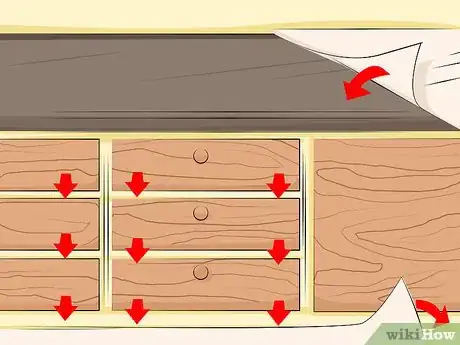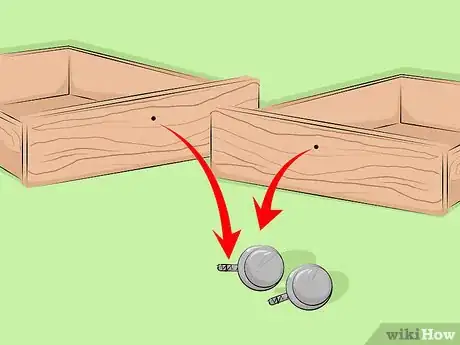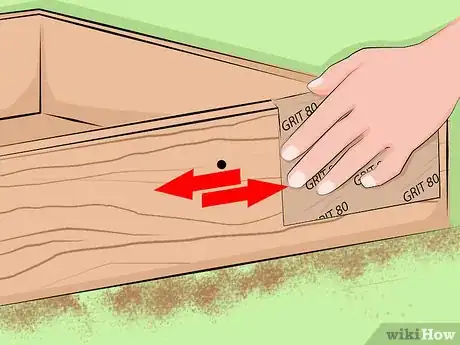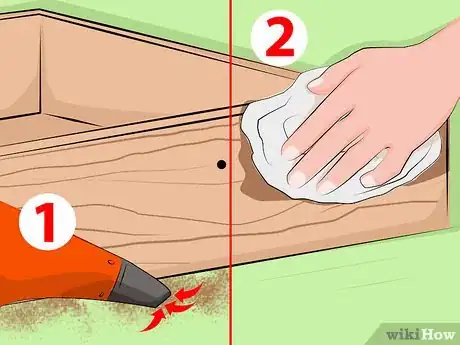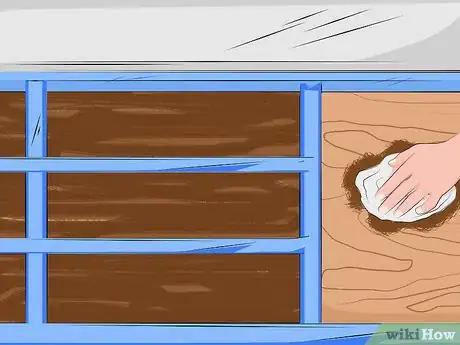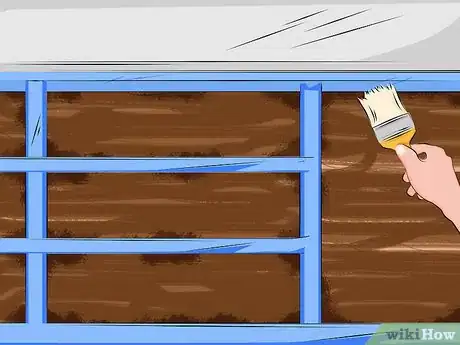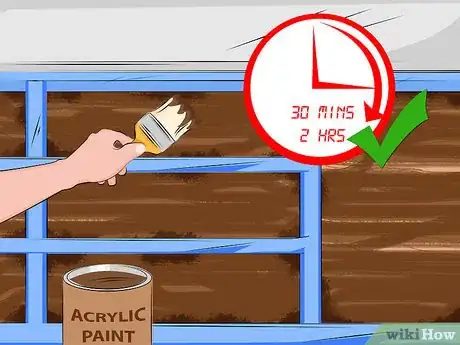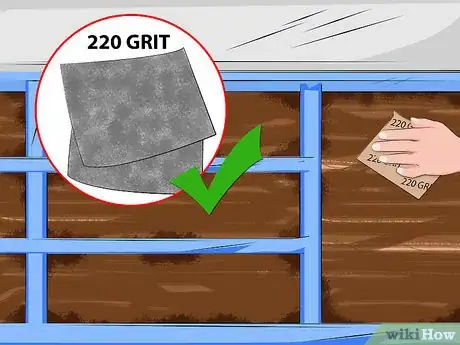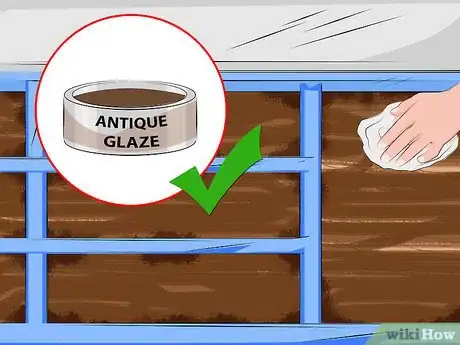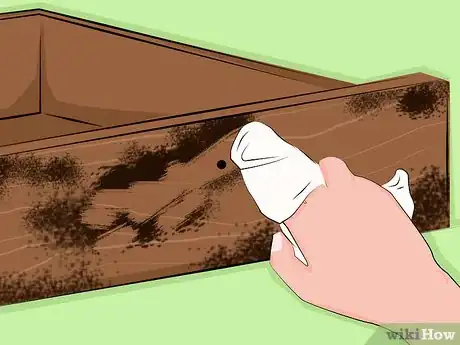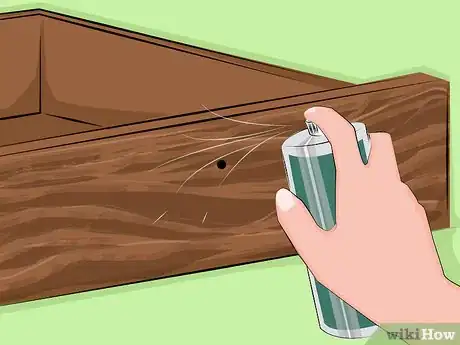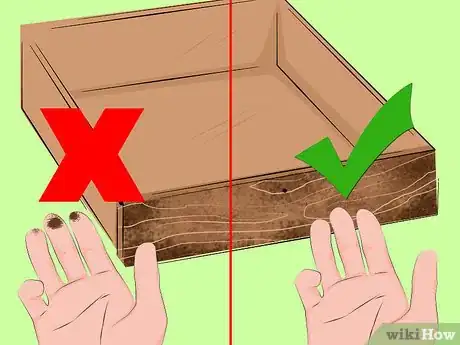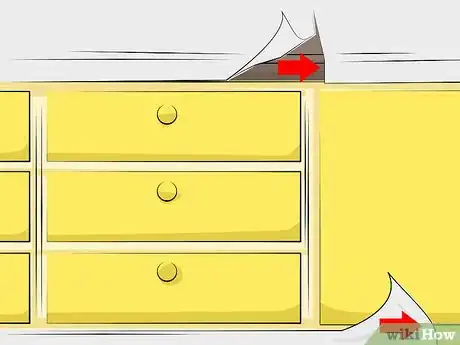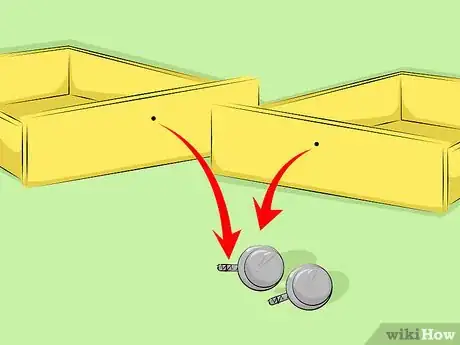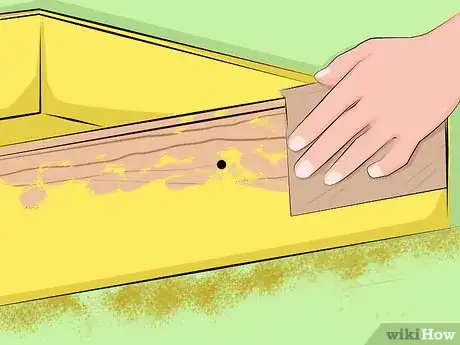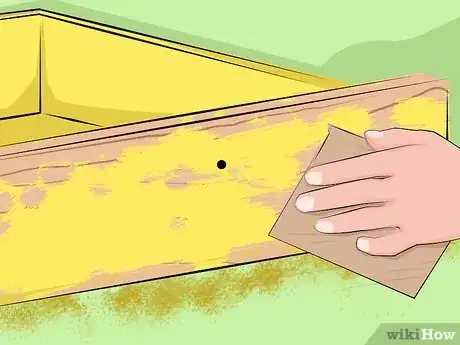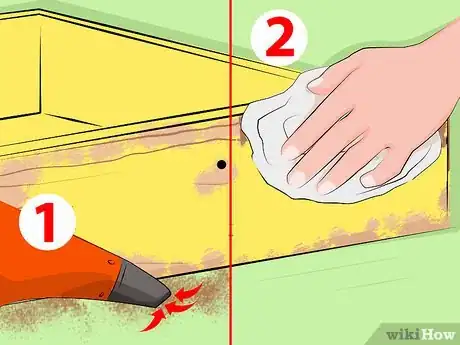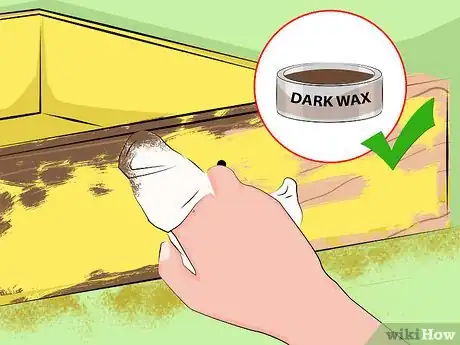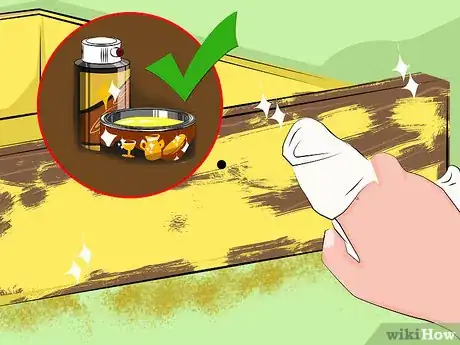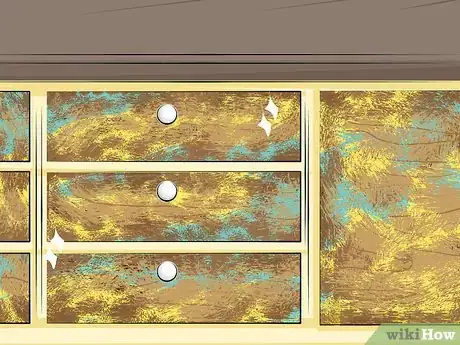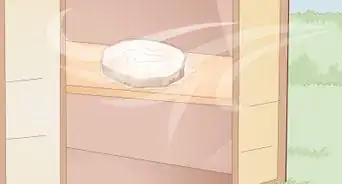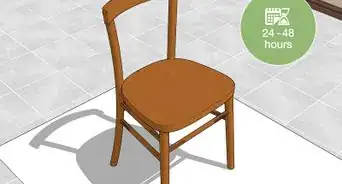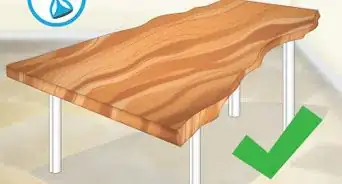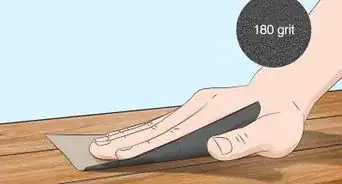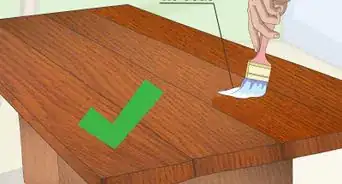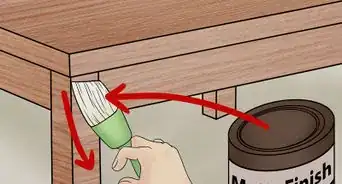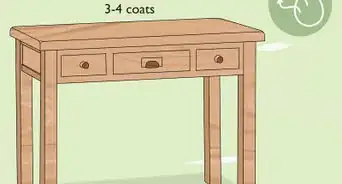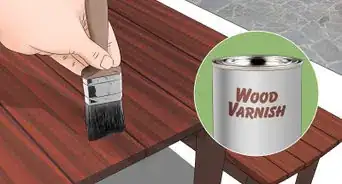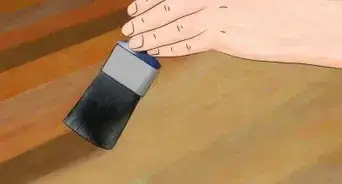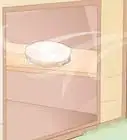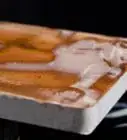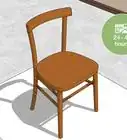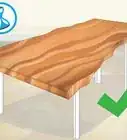This article was co-authored by Tanglewood Sue. Tanglewood Sue is a DIY and Upcycling Specialist and the Owner of Tanglewood Works out of Hyattsville, Maryland. With over nine years of experience, Sue specializes in upcycled painted furniture and other handmade, personalized, and sustainable goods. With her passion for art and reinvention, marketing experience, and Bachelor’s Degree in Broadcast Media, Sue has been able to create a business that not only provides quality pieces but empowers customers to create their works through her library of DIY tutorials and live demos as well as DIY supplies.
This article has been viewed 80,847 times.
Renovating a historic house can be a challenging and expensive proposition. If you crave the look of an old farmhouse kitchen without having to tackle that large of a project, distressing your existing cabinets may be your solution.
Steps
Weathering and Staining Cabinets
-
1Protect your work area. If your cabinet is a standalone piece, try to move it outside. If the cabinet is attached to the wall, cover your floors and counters with a painter's cloth or a cheap, plastic tablecloth. Move anything that might get stained by paint to a safer place.
- This method is suitable for painted, varnished, and unpainted cabinets. It will be easier on an unpainted cabinet, however.
-
2Remove knobs, handles, and any other hardware. Put them inside a box or a plastic, re-sealable bag so that they all stay together. Consider taping the screws to their corresponding hinges, knobs, and handles.Advertisement
-
3Sand down the entire surface of the cabinet using a 60 to 80 grit sandpaper. This is necessary for painted, varnished, and even unpainted cabinets. It roughs up the surface and gives the stain and paint something to stick to. Your weathering will last a lot longer as a result.[1]
- If you are working on a painted or varnished cabinet, keep sanding the until the raw wood starts to show. These areas will eventually get the stain, so the more you sand, the more weathered your cabinet will look.
-
4Vacuum your work area and wash the cabinets down to get rid of any dust. Get out your vacuum cleaner, and vacuum the floor. Wipe down the cabinets with a tack cloth. Follow up with a damp cloth. If your cabinets are in the kitchen, consider using an ammonia-based household cleaner or a degrease to get rid of any oil residue.
- Make sure you get rid of all the sawdust. Any dust that remains will get into your stain and/or paint, and mar the surface.[2] You'll get a messy finish instead of a weathered one.
-
5Mask off the areas you do not want to be painted with painter's tape. This includes glass paneling and the edges of the walls around your cabinets. Not only will you be keeping these areas safe and clean, but you'll also get nice, crisp lines later on.
-
6Rub a stain or glaze into the surface of the wood using a piece of cloth. This is the color that will peek through your paint after you "weather" it: You may need two to three layers of stain. Be sure to let each layer dry before applying the next.
- Consider going over the cabinet with a steel wire brush first. This will open up the wood grain and help the stain and/or paint to soak in better.
-
7Apply wax or petroleum jelly to the areas you want to distress.[3] It’s easiest to do this with a bristly paintbrush. This will protect the stain from the paint. The paint won't stick to these areas. When you are done painting, these areas will show through as "Weathering."[4]
- Try to keep these areas random but keep in mind that most weathering will occur on corners and edges.
- Buff off the wax with a clean rag once you're finished.[5]
-
8Apply a few coats of acrylic or latex furniture-grade paint, letting each layer to dry in between. It is better to apply many thin coats than one thick coat; it will give you the smoothest finish and lessens the appearance of brushstrokes. Most paints will dry to the touch and be ready for another coat in 30 minutes to 2 hours. Check the label on your can.
-
9Lightly sand the cabinet again once the paint is fully dry, and be sure to remove all the dust. Use 220 grit sandpaper this time. It will smooth down any brush strokes, and remove the excess wax or petroleum jelly. When you are done, vacuum your floor up and wipe the cabinet down with a tack cloth.[6]
- You can also use a steel wool pad to rub at the areas with the wax/petroleum jelly. This lets the stain show through.
-
10Consider applying some antiquing glaze for an aged look. If you really want to give your cabinets that old look, you'll need some antiquing glaze. Get out a clean rag and dip it into the glaze. You don't need a lot—a small amount will go a long way. Next, rub the glaze onto the cabinet using a small, circular motion. Let the glaze dry for the time specified by the manufacturer's directions.
- If you want a crackly look, use a crackle glaze instead. For large, wide cracks, apply a thick coat. For finer, more spidery cracks, apply a thinner coat.
- Once the cabinet is covered in glaze, you can smooth out the circular marks with a clean rag. Wipe the glaze up and down or side-to-side to get a lined look.
- If you’d like to darken the edges or small corners, apply the glaze using a small brush.
-
11Remove excess glaze, if necessary. With a rag wrapped around your finger, wipe away any glaze that’s inadvertently gotten in places you wish it weren’t. After this stage, allow your cabinets to dry before adding a topcoat.
- It's best to wait 24 hours, or at the very least overnight. You don't want to the two coats meshing together and marring your artwork.
- All the rags you've used should be washed together but separate from your other linens in your washing machine in case the glaze stains.
-
12Apply three coats of a clear sealer, allowing each coat dry before applying the next one. If you can, try to find a sealer that is non-yellowing. A good sealer to use is a polycrylic sealer. Avoid using polyurethane, if you can, as those tend to yellow over time.[7]
- How long the coats take to dry will depend on the sealer itself. Most sealers will dry within 2 to 3 hours, but you might want to refer to the label for more specific drying times.
- Check the label to make sure yours is non-yellowing.
- Some sealers need a curing period as well. This can take several hours to a few days. Do not get impatient or try to rush through. If you don't let your work cure properly, you'll get a sticky, tacky, gummy finish.
-
13Make sure that the sealer has fully cured before you replace the hardware on the cabinets. Check the label on the can that your sealer came in. Some sealers need a few days' curing time. This means that until they fully cure, the sealer will be sticky. During this time, you will want to leave the cabinets open so that they don't "glue shut. Once the sealer is fully dry and/or cured, you can replace the hinges, knobs, and handles.
Weathering Painted Cabinets
-
1Protect your work area from sanding dust. You won't be doing any painting, but you will be doing quite a lot of sanding. If possible, try to take your cabinets outside. If you can't, consider placing a painter's cloth down on the floor for easy cleanup.
-
2Remove all metal hardware and store it in a box or a plastic re-sealable bag. If the knobs or handles are made out of wood, consider leaving them on so that you can weather them too.
-
3Sand the edges and corners using a medium or 100 grit sandpaper. Use a quick, flicking motion. Keep going until some of the raw wood starts to show though. Don't worry about getting it perfectly even. It's okay if some parts of the edges and corners still have paint on them.[8]
- If you left the handles or knots on, give them a give buff with the sandpaper too. Focus on the areas that will get the more wear, sure such the edges.
-
4Go over the entire cabinet using a finer grit sanding sponge. This will help "blend" in the initial weathering you did on the edges. It will also buff the paint, making it look less new. It can also help give the cabinet a slight texture.[9]
-
5Clean the cabinet and your work area to get rid of any dust. If you don't do this, the dust will get into the wax in the next steps, which may result in a messy finish rather than a weathered one. Get out your vacuum cleaner, and vacuum the floor of your work area. Next, wipe down the entire cabinet using a tack cloth. Finish off by wiping it down with a damp cloth.
-
6Consider applying some dark wax onto the weathered edges and into the corners. This will help give your cabinet that distinctive weathered look. Apply the wax using a soft cloth or a foam sponge. Focus on the cracks and corners where dust and dirt are most likely to collect.
- You will want to buy specifically designed weathering wax for furniture. You can find it in hardware stores as well as in some arts and crafts stores.
-
7Finish off with furniture wax. This will not only re-seal the paint, but also help protect the raw edges you just uncovered through sanding. Start by applying a small amount of wax onto the tips of a large, short-bristled brush. Use small, circular motions to "massage" the wax into the cabinet. Work in small areas at a time, and pick up more wax with your brush as needed. Finish off by buffing the wax with the brush. It should not feel sticky when you are done.
- A small amount of wax goes a long way.
-
8Put your cabinet back together, if needed. If you took off the hardware, wait until the wax has absorbed into the cabinet, then put the hinges, knobs, and handles back on.
Expert Q&A
-
QuestionHow do I protect the inside of my cabinets when I'm done?
 Tanglewood SueTanglewood Sue is a DIY and Upcycling Specialist and the Owner of Tanglewood Works out of Hyattsville, Maryland. With over nine years of experience, Sue specializes in upcycled painted furniture and other handmade, personalized, and sustainable goods. With her passion for art and reinvention, marketing experience, and Bachelor’s Degree in Broadcast Media, Sue has been able to create a business that not only provides quality pieces but empowers customers to create their works through her library of DIY tutorials and live demos as well as DIY supplies.
Tanglewood SueTanglewood Sue is a DIY and Upcycling Specialist and the Owner of Tanglewood Works out of Hyattsville, Maryland. With over nine years of experience, Sue specializes in upcycled painted furniture and other handmade, personalized, and sustainable goods. With her passion for art and reinvention, marketing experience, and Bachelor’s Degree in Broadcast Media, Sue has been able to create a business that not only provides quality pieces but empowers customers to create their works through her library of DIY tutorials and live demos as well as DIY supplies.
DIY & Upcycling Specialist Contact paper is the super obvious solution. You just cut it to size and the use a credit card to smooth it out on each shelf.
Contact paper is the super obvious solution. You just cut it to size and the use a credit card to smooth it out on each shelf. -
QuestionHow do I make new cabinets look old?
 William & Shannon LatilWilliam & Shannon Latil are Furniture Refinishing & Home Remodeling Specialists and the Founders of Furniture Refinishing Services based in Houston, Texas. With over 30 years of experience, William and Shannon specialize in repairing and restoring wood furniture, refinishing kitchen cabinets, remodeling kitchens, and building live-edge wooden tables. William and Shannon have won Awards for Excellence from the Better Business Bureau and the Houston Chronicle Best Small Business Award. Their work has also been featured in Houston Press Magazine - Kitchen Design. Additionally, the Furniture Refinishing Services team has conducted major refinishing work on venues such as NRG Stadium and Minute Maid Park.
William & Shannon LatilWilliam & Shannon Latil are Furniture Refinishing & Home Remodeling Specialists and the Founders of Furniture Refinishing Services based in Houston, Texas. With over 30 years of experience, William and Shannon specialize in repairing and restoring wood furniture, refinishing kitchen cabinets, remodeling kitchens, and building live-edge wooden tables. William and Shannon have won Awards for Excellence from the Better Business Bureau and the Houston Chronicle Best Small Business Award. Their work has also been featured in Houston Press Magazine - Kitchen Design. Additionally, the Furniture Refinishing Services team has conducted major refinishing work on venues such as NRG Stadium and Minute Maid Park.
Furniture Refinishing & Home Remodeling Specialists Lightly sand off edges and corners with a 320 grit sandpaper and then apply interior wax to the entire front of the cabinet doors and drawers. To finish it, buff off with a clean rag.
Lightly sand off edges and corners with a 320 grit sandpaper and then apply interior wax to the entire front of the cabinet doors and drawers. To finish it, buff off with a clean rag. -
QuestionIf I want to have that cracked look, can I use that crackle glaze with Method 2?
 Community AnswerRust-Oleum came up with accent kits that create the distressed look and most acrylic paint suppliers have a finish called weathered wood gloss medium or finish. You can also DIY using Vaseline Intensive Care or petroleum jelly rubbed on freshly painted surface to create the faux distressed look.
Community AnswerRust-Oleum came up with accent kits that create the distressed look and most acrylic paint suppliers have a finish called weathered wood gloss medium or finish. You can also DIY using Vaseline Intensive Care or petroleum jelly rubbed on freshly painted surface to create the faux distressed look.
Things You’ll Need
Weathering and Staining Cabinets
- Cabinets
- Box or re-sealable bag (optional)
- Painter's tape (optional)
- Sandpaper, 60 – 80 grit, and 220 grit
- Ammonia-based household cleaner or dish soap and water (optional)
- Tack cloth
- Extra cloths for cleaning
- Foam brushes
- Small, bristly paintbrushes
- Antique or crackle glaze
- Latex paint and stain (optional)
- Clear sealer
Weathering Painted Cabinets
- Cabinets
- Box or re-sealable bag (optional)
- 100 grit sandpaper
- Fine grit sanding sponge
- Tack cloth
- Extra cloths for cleaning
- Dark weathering wax
- Clear furniture wax
- Large, short-bristled brush
Warnings
- For best results, avoid working when the weather is too humid. This can cause the paints, glazes, and sealers to cure improperly and result in a sticky, tacky, gummy finish.⧼thumbs_response⧽
- Some sealers, stains, and glazes have a strong smell. Be sure to leave a window open or have a fan on if you can't work outside. If you start to feel lightheaded or get a headache, take a break and move to a well-ventilated area until you feel better.⧼thumbs_response⧽
References
- ↑ http://www.thisoldhouse.com/toh/photos/0,,20209701_20476955,00.html
- ↑ http://www.ourfifthhouse.com/2011/07/how-to-distress-your-kitchen-cabinets.html?m=1
- ↑ William & Shannon Latil. Furniture Refinishing & Home Remodeling Specialists. Expert Interview. 29 October 2021.
- ↑ http://lovegrowswild.com/2014/06/how-to-distress-paint-with-vaseline/
- ↑ William & Shannon Latil. Furniture Refinishing & Home Remodeling Specialists. Expert Interview. 29 October 2021.
- ↑ Tanglewood Sue. DIY & Upcycling Specialist. Expert Interview. 24 March 2021.
- ↑ http://www.hgtv.com/kitchens/distressed-and-antiqued-kitchen-cabinets/page-3.html
- ↑ Tanglewood Sue. DIY & Upcycling Specialist. Expert Interview. 24 March 2021.
- ↑ Tanglewood Sue. DIY & Upcycling Specialist. Expert Interview. 24 March 2021.
About This Article
To distress cabinets, start by sanding them with 80-grit sandpaper to rough up the surface so the stain sticks. Then, use a cloth to rub a stain or glaze into the surface of the wood, adding more layers until you're satisfied with the color. Next, apply petroleum jelly to the parts of the cabinets you want to distress, focusing on the corners and edges since these are the places that usually weather first. When you're finished, apply a few coats of acrylic or latex paint. Finally, once the paint is dry, apply 3 coats of sealer to finish your cabinets. To learn how to distress cabinets that are already painted, scroll down!
